Infantry Equipment, Pattern 1914 - Belts, Braces, and Straps
 The Pattern 1914 Waist belt was introduced with the Infantry Equipment, Pattern 1914 in List of Changes entry L. of C. 16977, dated 30 August 1914. The Waist belt is 2 1/4-inches wide and was originally issued in two lengths, 42-inches and 48-inches respectively. It has a snake buckle fastening, two 2 1/4-inch side buckles, two rear straps with 1-inch buckles, and two rear straps without buckles. It can be adjusted from each end so that the rear straps can always be centered.
The Pattern 1914 Waist belt was introduced with the Infantry Equipment, Pattern 1914 in List of Changes entry L. of C. 16977, dated 30 August 1914. The Waist belt is 2 1/4-inches wide and was originally issued in two lengths, 42-inches and 48-inches respectively. It has a snake buckle fastening, two 2 1/4-inch side buckles, two rear straps with 1-inch buckles, and two rear straps without buckles. It can be adjusted from each end so that the rear straps can always be centered.
 As with all leather parts of the Pattern 1914 Infantry Equipment, the colour was changed from "Service Dress" to "London Brown" by List of Changes entry L. of C. 17219, 31 December 1914 / 30 March 1915. List of Changes entry L. of C. 17220, dated 9 April 1915, added a third "Extra large " size, which is 52-inches long.
As with all leather parts of the Pattern 1914 Infantry Equipment, the colour was changed from "Service Dress" to "London Brown" by List of Changes entry L. of C. 17219, 31 December 1914 / 30 March 1915. List of Changes entry L. of C. 17220, dated 9 April 1915, added a third "Extra large " size, which is 52-inches long.
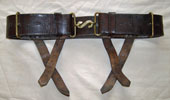 This British made 48-inch example, above and left, is in London Brown. The maker is obscure, but it is marked "London" and dated 1915. From the Chris Pollendine Collection, photographs © Chris Pollendine 2011.
This British made 48-inch example, above and left, is in London Brown. The maker is obscure, but it is marked "London" and dated 1915. From the Chris Pollendine Collection, photographs © Chris Pollendine 2011.
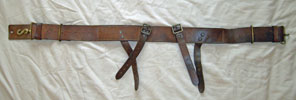 An American made Belt, as usual using the double cap rivets common to them. In London Brown colour, 48-inch "Large" size, maker marked "Cook" and dated 1915. From the Chris Pollendine Collection, photographs © Chris Pollendine 2011.
An American made Belt, as usual using the double cap rivets common to them. In London Brown colour, 48-inch "Large" size, maker marked "Cook" and dated 1915. From the Chris Pollendine Collection, photographs © Chris Pollendine 2011.
 An inside view of the same Belt.
An inside view of the same Belt.

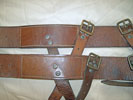 At far left, a front view. Near left is a detail comparison between the British (top) and American manufactured Belts.
At far left, a front view. Near left is a detail comparison between the British (top) and American manufactured Belts.
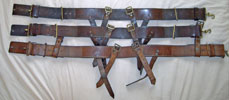
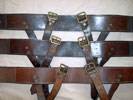 Three British Belts; the top two are the 48-inch size – This is the total, unfolded length, and not the maximum waist size! – Whilst the lower is the largest - ‘extra large’ at 52-inches. The middle one is marked with a large ‘L’, presumably qualifying the size. From the Chris Pollendine Collection, photographs © Chris Pollendine 2011.
Three British Belts; the top two are the 48-inch size – This is the total, unfolded length, and not the maximum waist size! – Whilst the lower is the largest - ‘extra large’ at 52-inches. The middle one is marked with a large ‘L’, presumably qualifying the size. From the Chris Pollendine Collection, photographs © Chris Pollendine 2011.
 The Pattern 1914 Braces were introduced with the Infantry Equipment, Pattern 1914 in List of Changes entry L. of C. 16977, dated 30 August 1914. Except for the colour change from "Service Dress" to "London Brown" by L. of C. entry 17219, 31 December 1914 / 30 March 1915, they remained unchanged throughout their service life. Each of the interchangeable Braces is a single strip of leather 53-inches long by 2-inches wide, shaped to 1-inch wide at the ends. Each is provided with a 2-inch tongued brass buckle for attaching the Pack or Haversack. These are maker marked "H.G.R. Ltd." and dated 1915. From the Paul Hannon Collection, photos © Paul Hannon 2011.
The Pattern 1914 Braces were introduced with the Infantry Equipment, Pattern 1914 in List of Changes entry L. of C. 16977, dated 30 August 1914. Except for the colour change from "Service Dress" to "London Brown" by L. of C. entry 17219, 31 December 1914 / 30 March 1915, they remained unchanged throughout their service life. Each of the interchangeable Braces is a single strip of leather 53-inches long by 2-inches wide, shaped to 1-inch wide at the ends. Each is provided with a 2-inch tongued brass buckle for attaching the Pack or Haversack. These are maker marked "H.G.R. Ltd." and dated 1915. From the Paul Hannon Collection, photos © Paul Hannon 2011.
 A second view of the same Braces.
A second view of the same Braces.
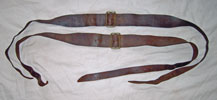
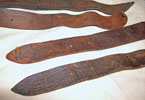 An American made pair of Braces. Noticeably thinner, (as is typical for American Pattern '14), by half in this case, than British leather. This well worn pair are neither maker marked nor dated. From the Chris Pollendine Collection, photographs © Chris Pollendine 2011.
An American made pair of Braces. Noticeably thinner, (as is typical for American Pattern '14), by half in this case, than British leather. This well worn pair are neither maker marked nor dated. From the Chris Pollendine Collection, photographs © Chris Pollendine 2011.
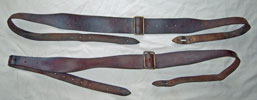
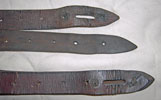 This British made pair have had a modification at some time, adding a buckle to one end of each, since removed. It seems they were often used in the post war period for attachment to golf caddies, shooting bags, fishing bags, civilian rucksacks etc. Nevertheless, the maker can still be made out – "Mc M & co, C & M" – They were curriers & manufacturers. Both are broad arrow marked. From the Chris Pollendine Collection, all photographs © Chris Pollendine 2011.
This British made pair have had a modification at some time, adding a buckle to one end of each, since removed. It seems they were often used in the post war period for attachment to golf caddies, shooting bags, fishing bags, civilian rucksacks etc. Nevertheless, the maker can still be made out – "Mc M & co, C & M" – They were curriers & manufacturers. Both are broad arrow marked. From the Chris Pollendine Collection, all photographs © Chris Pollendine 2011.

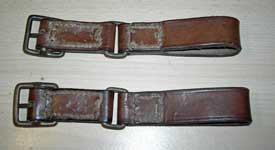 Approved on 24 February, 1915, and announced on 1 May, L. of C. 17698 introduced Brace attachments, a concept seen only for the second time under this nomenclature, but was the third evocation of the concept. For Patterns 1908, 1919, 1925, 1937 and 1944, the Brace attachment was the means by which Braces could still support the Waist belt, when each Pattern was rigged for a Pistol Order, the components for this all lacking a buckle by which the Brace could be secured. Whilst identical in concept, those for Pattern 1914 were rather different in application. The pair shown at left are from the Chris Pollendine Collection, photographs © Chris Pollendine 2010.
Approved on 24 February, 1915, and announced on 1 May, L. of C. 17698 introduced Brace attachments, a concept seen only for the second time under this nomenclature, but was the third evocation of the concept. For Patterns 1908, 1919, 1925, 1937 and 1944, the Brace attachment was the means by which Braces could still support the Waist belt, when each Pattern was rigged for a Pistol Order, the components for this all lacking a buckle by which the Brace could be secured. Whilst identical in concept, those for Pattern 1914 were rather different in application. The pair shown at left are from the Chris Pollendine Collection, photographs © Chris Pollendine 2010.
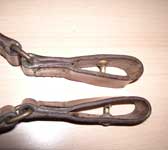
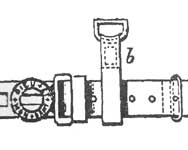 The story actually starts in Victorian times, when Valise Equipment, Pattern 1882 was announced. The Pattern introduced an item completely new to the British Army – the Brace attachment, which here was termed a Chape, leather, buff, waistbelt, for brace; Army Hospital Corps. (Mark I.). This was a vertically extended runner, which carried a brass dee, to which the diagonal strap of the Brace could be attached. Only one was authorised and only for use by Sergeants and Rank and File of the Army Hospital Corps. Where the Infantry carried a pair of pouches, each with a brace dee, the A.H.C. carried a single Ammunition pouch, so the Chape provided the other supporting point. The illustration near left is taken from L. of C. 3994, Valise Equipment, Pattern 1882, dated 13th January 1882.
The story actually starts in Victorian times, when Valise Equipment, Pattern 1882 was announced. The Pattern introduced an item completely new to the British Army – the Brace attachment, which here was termed a Chape, leather, buff, waistbelt, for brace; Army Hospital Corps. (Mark I.). This was a vertically extended runner, which carried a brass dee, to which the diagonal strap of the Brace could be attached. Only one was authorised and only for use by Sergeants and Rank and File of the Army Hospital Corps. Where the Infantry carried a pair of pouches, each with a brace dee, the A.H.C. carried a single Ammunition pouch, so the Chape provided the other supporting point. The illustration near left is taken from L. of C. 3994, Valise Equipment, Pattern 1882, dated 13th January 1882.
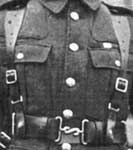
 The Patt. ’14 Brace attachment was issued in pairs and were stated to be for “…unarmed Units…”. Such units were primarily the Royal Army Medical Corps, the descendants of the old A.H.C. It was a simple construction in 1-inch strapping, a short upper section, doubled and stitched, carrying a Buckle, brass, 1-inch and the lower section doubled and stitched, forming a belt loop. The two sections were linked together with a Loop, brass, 1 1/16-inch. The front part of the belt loop carried an inward facing billet hook (see detail photo, far left above). This was engaged in the adjustment holes of the Waist belt, to prevent lateral movement. The loop allowed the brace end to be passed through it, to lie behind the Brace attachments, where they could be attached to the Water bottle carrier and Haversack. Where the Patt. ’08 Brace attachment had a diagonal strap, the Patt. ’14 did not, as this strap was actually riveted to the rear of the Belt (see Belt section above). It's worth mentioning that two different variations of Patt. '14 Brace attachments have been noted. One type, as shown above and left, is of sewn construction, whilst another version (right) is rivetted.
The Patt. ’14 Brace attachment was issued in pairs and were stated to be for “…unarmed Units…”. Such units were primarily the Royal Army Medical Corps, the descendants of the old A.H.C. It was a simple construction in 1-inch strapping, a short upper section, doubled and stitched, carrying a Buckle, brass, 1-inch and the lower section doubled and stitched, forming a belt loop. The two sections were linked together with a Loop, brass, 1 1/16-inch. The front part of the belt loop carried an inward facing billet hook (see detail photo, far left above). This was engaged in the adjustment holes of the Waist belt, to prevent lateral movement. The loop allowed the brace end to be passed through it, to lie behind the Brace attachments, where they could be attached to the Water bottle carrier and Haversack. Where the Patt. ’08 Brace attachment had a diagonal strap, the Patt. ’14 did not, as this strap was actually riveted to the rear of the Belt (see Belt section above). It's worth mentioning that two different variations of Patt. '14 Brace attachments have been noted. One type, as shown above and left, is of sewn construction, whilst another version (right) is rivetted.
Attachments, brace, Officer's, Private Purchase (?)


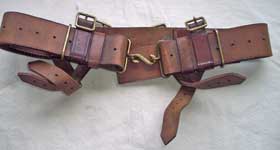 Although not Patt. '14 items proper, this is a very interesting pair of Brace attachments. Infantry Equipment, Pattern 1914 did not make provision for officers' equipment. As stated in the introductory L. of C., the Pistol Equipment was intended for "Pipers and Range-Takers", just as was the earlier Patt. '08 Pistol Equipment. Steve Hewitt, however, has this Belt and its Brace attachments, formerly the property of an officer, in his Collection. These Brace attachments would have replaced the Patt. '14 Ammunition pouches, which of course he would not have needed, and provided connection points for the front ends of the Braces. Had he also used the Patt. '14 Pistol case and Cartridge pouch, these would not have been required. With them, though, his existing Sam Browne Pistol case and Ammunition pouch could have been retained. These Brace attachments are very well made, but simple enough to fabricate - just a loop of leather sewn to a buckle, and lacking the billet hook of the proper Patt. '14 item - that it can't really be determined whether they were commercial Private Purchase items, or something the original owner had made up by a skilled leather worker. The buckles do appear to be correct Patt. '14 pieces. In either case, it is interesting to see Patt. '14 adapted for use by an officer. Can any reader supply period photos showing an officer in Patt. '14? The Belt, by the way, is British made and 1915 dated. Photos © Steve Hewitt 2011.
Although not Patt. '14 items proper, this is a very interesting pair of Brace attachments. Infantry Equipment, Pattern 1914 did not make provision for officers' equipment. As stated in the introductory L. of C., the Pistol Equipment was intended for "Pipers and Range-Takers", just as was the earlier Patt. '08 Pistol Equipment. Steve Hewitt, however, has this Belt and its Brace attachments, formerly the property of an officer, in his Collection. These Brace attachments would have replaced the Patt. '14 Ammunition pouches, which of course he would not have needed, and provided connection points for the front ends of the Braces. Had he also used the Patt. '14 Pistol case and Cartridge pouch, these would not have been required. With them, though, his existing Sam Browne Pistol case and Ammunition pouch could have been retained. These Brace attachments are very well made, but simple enough to fabricate - just a loop of leather sewn to a buckle, and lacking the billet hook of the proper Patt. '14 item - that it can't really be determined whether they were commercial Private Purchase items, or something the original owner had made up by a skilled leather worker. The buckles do appear to be correct Patt. '14 pieces. In either case, it is interesting to see Patt. '14 adapted for use by an officer. Can any reader supply period photos showing an officer in Patt. '14? The Belt, by the way, is British made and 1915 dated. Photos © Steve Hewitt 2011.
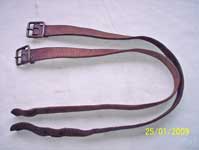
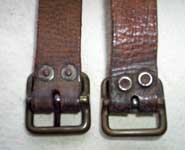 The Pattern 1914 Pack straps were introduced with the Infantry Equipment, Pattern 1914 in List of Changes entry L. of C. 16977, dated 30 August 1914. They are 27-inches by 1-inch wide and are fitted with tongued buckles. The Pack straps are designed to attach to the 1-inch tabs without buckles at the rear of the Waist belt, after these tabs have been passed through the loops at the bottom of the Pack and attached to the lower 1-inch chapes on the rear of the Pack. After attaching to the tabs, the straps cross over the Pack and attach to the 1-inch chapes at the top rear. Together the tabs and Pack straps form a cradle which transfers the load of the Pack from the shoulder to the waist. As with all leather parts of the Pattern 1914 Infantry Equipment, the colour was changed from "Service Dress" to "London Brown" by List of Changes entry L. of C. 17219, 31 December 1914 / 30 March 1915. Except for the colour, the Pack straps remained unchanged throughout their service life. The Straps shown here are interesting London Brown examples. They are not a matched pair. In the picture far left, the one shown on the outside (buckle above) is British made, while the Strap on the inside is American. The picture of the buckles, near left, shows the difference. In this picture, the British example is on the left. You can see the typical British military tinned brass hose rivets. The American made example uses the single piece steel rivets seen on US made pieces of Infantry Equipment, Pattern 1914. Neither strap is maker marked or dated. From the Steve Hewitt collection. Photos © Steve Hewitt 2009.
The Pattern 1914 Pack straps were introduced with the Infantry Equipment, Pattern 1914 in List of Changes entry L. of C. 16977, dated 30 August 1914. They are 27-inches by 1-inch wide and are fitted with tongued buckles. The Pack straps are designed to attach to the 1-inch tabs without buckles at the rear of the Waist belt, after these tabs have been passed through the loops at the bottom of the Pack and attached to the lower 1-inch chapes on the rear of the Pack. After attaching to the tabs, the straps cross over the Pack and attach to the 1-inch chapes at the top rear. Together the tabs and Pack straps form a cradle which transfers the load of the Pack from the shoulder to the waist. As with all leather parts of the Pattern 1914 Infantry Equipment, the colour was changed from "Service Dress" to "London Brown" by List of Changes entry L. of C. 17219, 31 December 1914 / 30 March 1915. Except for the colour, the Pack straps remained unchanged throughout their service life. The Straps shown here are interesting London Brown examples. They are not a matched pair. In the picture far left, the one shown on the outside (buckle above) is British made, while the Strap on the inside is American. The picture of the buckles, near left, shows the difference. In this picture, the British example is on the left. You can see the typical British military tinned brass hose rivets. The American made example uses the single piece steel rivets seen on US made pieces of Infantry Equipment, Pattern 1914. Neither strap is maker marked or dated. From the Steve Hewitt collection. Photos © Steve Hewitt 2009.
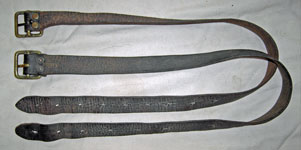
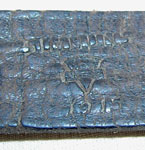 Another pair – oddly enough, these are also one British and one American made – maybe a swap is in order! A nice clear marking on the American one, showing it was made by "Simmons – Keen Kutter", and dated 1915. From the Chris Pollendine Collection, photographs © Chris Pollendine 2011.
Another pair – oddly enough, these are also one British and one American made – maybe a swap is in order! A nice clear marking on the American one, showing it was made by "Simmons – Keen Kutter", and dated 1915. From the Chris Pollendine Collection, photographs © Chris Pollendine 2011.
 A third pair of Pack straps. This time, one Strap is definitely American made, but they differ in detail and are from different manufacturers. The American one (top) is maker marked "R.H. Long" and dated 1915*. This example is unusual for American made Patt. '14 in using hose rivets, instead of the more common American single piece steel rivets. The other Strap is not marked or dated, and also has hose rivets typical of British production. Note that the buckles are slightly different in size and shape. Owned by an anonymous British collector.
A third pair of Pack straps. This time, one Strap is definitely American made, but they differ in detail and are from different manufacturers. The American one (top) is maker marked "R.H. Long" and dated 1915*. This example is unusual for American made Patt. '14 in using hose rivets, instead of the more common American single piece steel rivets. The other Strap is not marked or dated, and also has hose rivets typical of British production. Note that the buckles are slightly different in size and shape. Owned by an anonymous British collector.
*R. H. Long were American manufacturers that in 1917-18 made a large number of web and leather equipment items for the U. S. Army. R. H. Long, Framingham, Massachusetts, U.S.A., manufactured: canteen covers M1910 and M1917, haversacks M1910, pack carriers M1910, shovel carriers M1910, cleaning rod cases M1910, pistol belts M1912, ration bags M1912, bandoliers, helmet linings-M1917 helmet, and cartridge belts 1917-18.
-Thanks to Richard Ellis for informing us that Long were American makers, and for the information on the firm given here.






